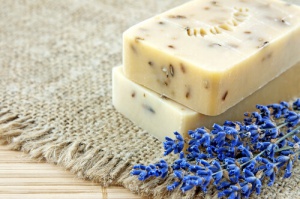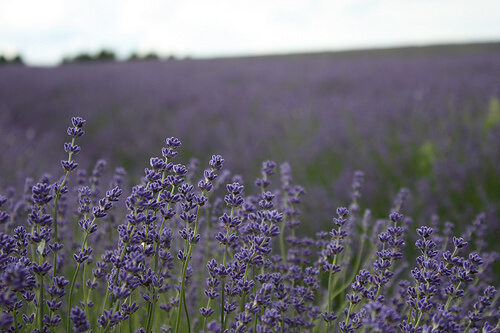How to Make Homemade Lavender Soap

In this article, we will provide a step by step guide on how to make natural lavender soap at home with two recipes. One recipe is more elaborate, while the other is more simple. This lavender soap provides several benefits and can be used in several ways. It is also a very inexpensive and an original gift.
Why lavender soap?
We will talk about a few reasons as to why we recommend making your own lavender soap:
- It’s a relaxing plant.
- Because it’s antiseptic, astringent, antiviral, and antibacterial, which is why it is very recommended for improving the healing of cuts, dermatitis, eczema, acne, boils, or burns.
- Lavender is frequently used in cleaning products.
- Its purple color gives it an original touch.
- Because it has a delicious aroma.
- It’s a very smooth plant, also recommended for children and babies.
- We can use this soap to add fragrance to dressers, clothing, the bed, etc.
- It’s a simple and original gift.
We recommend you read:
Natural Remedies for Scars
Ingredients for soap making
First, we will list the ingredients to use for the lavender soap:
- 210 ml olive oil or sunflower oil
- 30 grams caustic soda
- 65 ml distilled water
- Lavender essential oil
- Fresh or dried lavender flowers
You should also prepare the following utensils:
- A pan in whatever shape you like. One option is to cut off the bottom of a bottle or a brick. Do not use aluminum molds
- Protective glasses for handling the caustic soda
- Hand blender
- Cooking pot
- Glass bowl
- Wooden spoon for stirring
Directions for making lavender soap
- Get the pan ready and first, place a few lavender flowers in it so that when you remove the soap from the mold, the flowers show up on the top portion of the soap.
- Carefully, and while using protective glasses, place the glass bowl in the sink and put the caustic soda in it. Then add the distilled water. Follow this order to avoid splashing because this process produces a reaction that causes gasses, allow to sit until it cools. Ideally, you should do this by an open window, so as to ventilate well as soon as possible.
- Place the oil in the pot, and warm over low heat. When the oil has heated to about 40 degrees Celsius, remove from heat and carefully mix in the caustic soda, using the hand blender. Keep it from splashing. Beat until the mixture becomes thick and gel-like.
- Then, and without waiting for it to cool, add 20 to 30 drops of lavender essential oil and more lavender flowers. Mix well.
- Pour this mixture into the mold and add more lavender flowers so they are visible from this side as well.
- Cover with a towel to retain heat until it turns to soap. Let sit until it cools, between 12 and 24 hours, making sure not to move or stir it.
- Once it’s cold you can remove it from the mold. Leave in a fresh and dry place so that it becomes hard and matures, between one and a half to two months.
Some more recommendations
If you are satisfied with the results you can make more the next time, multiplying the ingredients proportionally and using several molds, or even a plum-cake mold. If you decide to use this mold, cut the soap with a knife into pieces once it has already cooled. Store slightly separated so that it can mature and dry well.
We recommend handling the caustic soda with great care, always keeping children and pets far away. Always use protective glasses, and even a mask and gloves, because this material is very corrosive. If it ever touches your skin at any time, immediately apply a bit of vinegar to it.
A very simple alternative recipe
If you don’t want to complicate things too much, we have a more simple option that is also homemade. Buy a transparent or clear glycerin bar. Place it in a double boiler until it melts, then add a few drops of essential lavender oil and a few lavender flowers. While still hot, place in a pan that is the desired shape, and allow to cool down.
Photos courtesy of LilBaysoap, svendah, and FelinusNoir.
All cited sources were thoroughly reviewed by our team to ensure their quality, reliability, currency, and validity. The bibliography of this article was considered reliable and of academic or scientific accuracy.
- Koulivand PH, Khaleghi Ghadiri M, Gorji A. Lavender and the nervous system. Evid Based Complement Alternat Med. 2013;2013:681304. doi:10.1155/2013/681304
- Han SH, Hur MH, Buckle J, Choi J, Lee MS. Effect of aromatherapy on symptoms of dysmenorrhea in college students: A randomized placebo-controlled clinical trial. J Altern Complement Med. 2006 Jul-Aug;12(6):535-41. doi: 10.1089/acm.2006.12.535. PMID: 16884344.
- Malcolm BJ, Tallian K. Essential oil of lavender in anxiety disorders: Ready for prime time?. Ment Health Clin. 2018;7(4):147-155. Published 2018 Mar 26. doi:10.9740/mhc.2017.07.147
- Keshavarz Afshar M, Behboodi Moghadam Z, Taghizadeh Z, Bekhradi R, Montazeri A, Mokhtari P. Lavender fragrance essential oil and the quality of sleep in postpartum women. Iran Red Crescent Med J. 2015;17(4):e25880. Published 2015 Apr 25. doi:10.5812/ircmj.17(4)2015.25880
- Mori HM, Kawanami H, Kawahata H, Aoki M. Wound healing potential of lavender oil by acceleration of granulation and wound contraction through induction of TGF-β in a rat model. BMC Complement Altern Med. 2016;16:144. Published 2016 May 26. doi:10.1186/s12906-016-1128-7
This text is provided for informational purposes only and does not replace consultation with a professional. If in doubt, consult your specialist.










